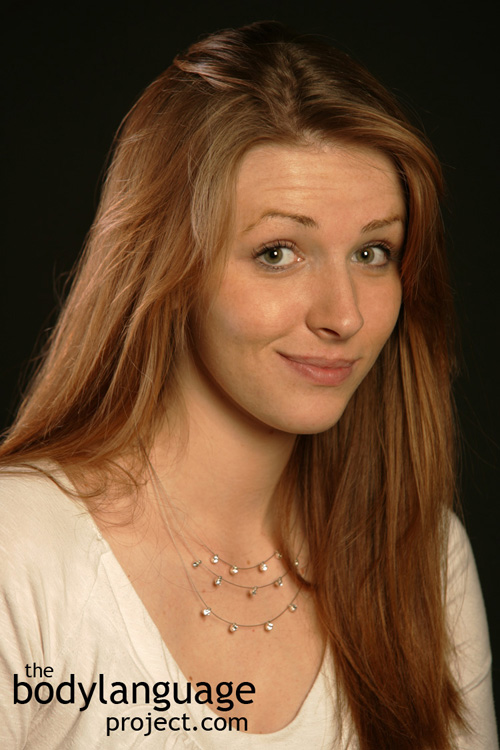Body Language of Eyebrow Hold
Synonym(s): Eyebrow Shrug.
Description: Happens when the eyebrows raise and pause for a second before being lowered.
In One Sentence: The eyebrow hold is a signal that a person is dumbfounded and is questioning what they are hearing or seeing.
How To Use it: Hold the eyebrows up when you want to make a nonverbal inquiry. Holding the eyebrows up momentarily, is a way to ask people to complete their thought. In other words, you are holding your eyebrows up awkwardly in hopes they will resolve the problem so you can drop them back down.
Mothers can use this effectively with misbehaving children. Simply raise the eyebrows, cock the head to the side, make your request, and wait for a correct response before lowering them.
Context: General.
Verbal Translation: a) “I’m raising my eyebrows and I’m willing to hold them here until someone steps in and fixed my problem.” B) “So, what do you think, have I don’t a good job?”
Variant: See Eyebrow Raise, Eyebrow Cock, Eyebrow Hold, Eyebrow Lowering, Eyebrow Flash, Eyebrows Knit or Oblique Eyebrows Of Grief.
Cue In Action: The speaker would often raise his eyebrows as he told a joke and held them up. He wanted and expected applause.
Meaning and/or Motivation: Eyebrow hold indicates a lack of knowledge or even helplessness. It is a mild form of unpleasant surprise. Eyebrows are held up when someone seeks approval from others. This approval may come nonverbally as a head nod or smile or a verbal agreement.
Politicians and children often raise their eyebrows and hold them up waiting for approval from others.
Cue Cluster: The eyebrow hold is sometimes accompanied by palms up, as if “offering.”
Body Language Category: Confused, Eye Language, Microexpressions, Nonthreatening body language, Open facial gestures, Submissive body language.
Resources:
Duan, Xujun ; Dai, Qian ; Gong, Qiyong ; Chen, Huafu. Neural mechanism of unconscious perception of surprised facial expression. NeuroImage. 2010. 52(1): 401-407.
e Charlesworth, W. R. (1964). Instigation and maintenance of curiosity behavior as a function of surprise versus novel and familiar stimuli. Child Development, 35, 1169–1186.
Ekman, P. & O’Sullivan, M. (1991). Who can catch a liar? American Psychologist. 46, 913-920.
Grammer, Karl ; Schiefenhövel, Wulf ; Schleidt, Margret ; Lorenz, Beatrice ; Eibl eibesfeldt, Irenäus. Patterns on the Face: The Eyebrow Flash in Crosscultural Comparison. Ethology. 1988. 77(4): 279-299.
Hall, Judith ; LeBeau, Lavonia ; Reinoso, Jeannette ; Thayer, Frank. Status, Gender, and Nonverbal Behavior in Candid and Posed Photographs: A Study of Conversations Between University Employees. Sex Roles. 2001 44(11): 677-692.
Ludden, G. D. S., Schifferstein, H. N. J., & Hekkert, P. (2009). Visual–tactual incongruities in products as sources of surprise. Empirical Studies of the Arts, 27, 63–89.
Martin, David John. 1997. Slaughtering a sacred cow: The eyebrow flash is not a universal social greeting. Dissertation Abstracts International: Section B: The Sciences and Engineering 58(5-B): 2751.
Moore, Monicam. Human Nonverbal Courtship Behavior—A Brief Historical Review. Journal of Sex Research. 2010 47(2-3): 171-180.
Moore, Monica. Courtship Signaling and Adolescents: Girls Just Wanna Have Fun. Journal of Sex Research. 1995. 32(4): 319-328.
http://bodylanguageproject.com/articles/girls-just-want-to-have-fun-the-origins-of-courtship-cues-in-girls-and-women/
Navarro, Joe. 2008. What Every BODY is Saying: An Ex-FBI Agent’s Guide to Speed-Reading People. William Morrow Paperbacks.
Parzuchowski, Michal ; Szymkow-Sudziarska, Aleksandra. Well, slap my thigh: expression of surprise facilitates memory of surprising material. Emotion. 2008. 8(3): 430-4.
Reisenzein, R. (2000). Exploring the strength of association between the components of emotion syndromes: the case of surprise. Cognition and Emotion, 14, 1–38.
Reisenzein, R., Bördgen, S., Holtbernd, T., & Matz, D. (2006). Evidence for strong dissociation between emotion and facial displays: the case of surprise. Journal of Personality and Social Psychology, 91, 295–315.
Reisenzein, R., & Studtmann, M. (2007). On the expression and experience of surprise: no evidence for facial feedback, but evidence for a reverse self-inference effect. Emotion, 7, 612–627.
Scherer, K. R., Zentner, M. R., & Stern, D. (2004). Beyond surprise: the puzzle of infants’ expressive reactions to expectancy violation. Emotion, 4, 389–402.
Schützwohl, Achim ; Reisenzein, Rainer. Facial expressions in response to a highly surprising event exceeding the field of vision: a test of Darwin’s theory of surprise. Evolution and Human Behavior. 2012. 33(6): 657-664.
Teixeira Fiquer, Juliana; Paulo Sérgio Boggio and Clarice Gorenstein. Talking Bodies: Nonverbal Behavior in the Assessment of Depression Severity. Journal of Affective Disorders. 2013. 150: 1114-1119.
http://bodylanguageproject.com/articles/using-nonverbal-behaviour-to-assess-depression-severity/
Vrticka, Pascal ; Lordier, Lara ; Bediou, Benoît ; Sander, David Desteno, David (editor). Human Amygdala Response to Dynamic Facial Expressions of Positive and Negative Surprise. Emotion. 2014. 14(1): 161-169.
Vanhamme, J. (2000). The link between surprise and satisfaction: an exploratory research on how to best measure surprise. Journal of Marketing Management, 16, 565–582.
Watt, Roger ; Craven, Ben ; Quinn, Sandra. A role for eyebrows in regulating the visibility of eye gaze direction. The Quarterly Journal of Experimental Psychology. 2007. 60(9): 1169-1177.
Wheldall, Kevin ; Mittler, Peter. Eyebrow-raising, eye widening and visual search nursery school children. Journal of Child Psychology and Psychiatry. 1976. 17(1): 57-62.

